Brussels Central Station
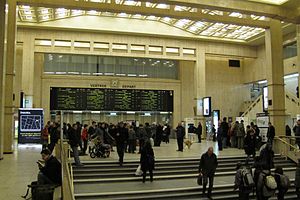 Main hall of Brussels-Central railway station | ||
| Location | Carrefour de l'Europe / Europakruispunt 2 B-1000 City of Brussels, Brussels-Capital Region | |
| Coordinates | 50°50′44″N 4°21′25″E / 50.84556°N 4.35694°ECoordinates: 50°50′44″N 4°21′25″E / 50.84556°N 4.35694°E | |
| Owned by | SNCB/NMBS | |
| Operated by | SNCB/NMBS | |
| Line(s) | North–South connection | |
| Platforms | 3 (central) | |
| Tracks | 6 | |
| Connections | ||
| Construction | ||
| Architect | Victor Horta, Maxime Brunfaut | |
| Architectural style | Modernism | |
| Other information | ||
| Station code | FBCL | |
| Website | Official website | |
| History | ||
| Opened | 4 October 1952 | |
| Services | ||
|
InterCity (IC), Tourist (ICT), Peak Hour (P), RER/GEN (S)
| ||
| Location | ||
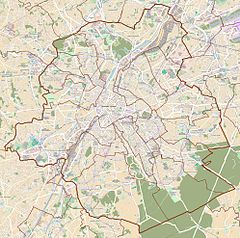 Brussels Central Location within Brussels | ||
Brussels Central Station (French: Gare de Bruxelles-Central, Dutch: Station Brussel-Centraal), officially Brussels Central (French: Bruxelles-Central, Dutch: Brussel-Centraal), is a railway and metro station in central Brussels, Belgium. It is the second busiest railway station in Belgium[1] and one of three principal railway stations in Brussels, together with Brussels-South and Brussels-North. First completed in 1952 after protracted delays caused by economic difficulties and World War II, it is the newest of Brussels' main rail hubs.
Brussels Central is connected to the Gare Centrale/Centraal Station station on lines 1 and 5 of the Brussels metro system, and serves as an important node of the Brussels Intercommunal Transport Company (STIB/MIVB).
History[]
During the late 19th and early 20th centuries, Brussels-North and Brussels-South were the primary railway stations in Brussels (Brussels-North slowly supplanted the original Allée Verte/Groendreef railway station near the same site). However, they were joined only by an inadequate single track running along what is today the route of Brussels' inner ring road. Many proposals were put forward to link the two stations more substantially. A law was finally passed in 1909 mandating a direct connection.

The famed architect Victor Horta was awarded the design of the Central Station building complex in 1910. He finished the initial version in 1912. Plans for the station originally featured a major urban redevelopment project, for which land was purchased and over 1,000 buildings demolished in the 1920s.[2] The Putterie/Putterij district began to be razed to make way for the underground station and building complex. However, work was halted by the World War I. Financial constraints limited work after the war, and in 1927, the government suspended the project altogether. In 1935, a new office dedicated to the project was set up and work resumed. The Central Station was planned as a hub in the connection. However, World War II slowed construction again. The interruptions and delays to construction left large areas filled with debris and craters for decades.[3]
Horta returned to work on the station after the end of the war. The building was completed according to Horta's plans by an architectural team led by Maxime Brunfaut, who expanded them by adding a new train line to the national airport and several underground passageways for pedestrians.[4][5]
An Islamic jihadist attempted to detonate a bomb in the station in the June 2017 Brussels attack.
Railway station[]
The railway station has six tracks, served by three island platforms. These are underground, beneath the city blocks within Boulevard de l'Impératrice/Keizerinlaan, Rue de l'Infante Isabelle/Infante Isabellastraat, the Kantersteen and Rue de la Putterie/Putterijstraat. The main entrance and ticket office are at ground level on Boulevard de l'Impératrice, and there are several other entrances on the other streets.
The station was renovated between 2004 and 2010 in an attempt to better equip it to present levels of usage (which can reach 150,000 passengers/day on the busiest days). Two new entrances were created on that occasion, and the main entrance was extensively renovated. The Carrefour de l'Europe/Europakruispunt, a pedestrianised square, was created in front of the station.[6] Plans then came for the renovation of the tunnel which links the main station with the metro stop. It has been described as dilapidated, dirty, and permanently tinged by the smell of urine.[7] An architectural firm had been retained in 2010 to implement the project designed to make the hallway a better "window" to Brussels for the many travellers who begin their journey there. The new tunnel with hops and a more luminous, graffiti resistant environment were completed in 2013.
Although Brussels' Central Station is at the very heart of the city, its capacity is not adapted to present usage levels (c. 70,000 passengers on a weekday), let alone future levels. The interior and the platforms have been renovated in recent years, but the main problem (i.e. lack of capacity) has not fundamentally been addressed. There have been suggestions to expand the station, but none of them has gained widespread acceptance. Today, at peak times, about 96 trains an hour use the six platforms of the station. With passenger growth expected to average 4% per year in the coming decade, Infrabel, the administrator of the Belgian rail network, has determined that an expansion of the rail capacity and of the Central Station will be necessary.[8] The CEO of Infrabel has estimated the cost of an adequate expansion at least €1 billion, and has said it will be necessary to complete the project by 2020.[9] However, the task of getting all relevant authorities to agree on a plan has so far proved difficult. Some credit a general taboo against discussions of expanding the North–South rail axis as a result of the history of extended delays and widespread destruction of neighbourhood blocks that the initial construction brought between 1911 and 1952.
Train services[]
The station is served by the following services:
- Intercity services (IC-35) Amsterdam - The Hague - Rotterdam - Roosendaal - Antwerp - Brussels Airport - Brussels
- Intercity services (IC-16) Brussels - Namur - Arlon - Luxembourg
- Intercity services (IC-01) Ostend - Bruges - Gent - Brussels - Leuven - Liege - Welkenraedt - Eupen
- Intercity services (IC-03) Knokke/Blankenberge - Bruges - Gent - Brussels - Leuven - Hasselt - Genk
- Intercity services (IC-05) Antwerp - Mechelen - Brussels - Nivelles - Charleroi (weekdays)
- Intercity services (IC-06) Tournai - Ath - Halle - Brussels - Brussels Airport
- Intercity services (IC-06A) Mons - Braine-le-Comte - Brussels - Brussels Airport
- Intercity services (IC-11) Binche - Braine-le-Comte - Halle - Brussels - Mechelen - Turnhout (weekdays)
- Intercity services (IC-12) Kortrijk - Gent - Brussels - Leuven - Liege - Welkenraedt (weekdays)
- Intercity services (IC-14) Quiévrain - Mons - Braine-le-Comte - Brussels - Leuven - Liege (weekdays)
- Intercity services (IC-17) Brussels - Namur - Dinant (weekends)
- Intercity services (IC-18) Brussels - Namur - Liege (weekdays)
- Intercity services (IC-20) Gent - Aalst - Brussels - Hasselt - Tongeren (weekdays)
- Intercity services (IC-20) Gent - Aalst - Brussels - Dendermonde - Lokeren (weekends)
- Intercity services (IC-22) Essen - Antwerp - Mechelen - Brussels (weekdays)
- Intercity services (IC-22) Antwerp - Mechelen - Brussels - Halle - Braine-le-Comte - Binche (weekends)
- Intercity services (IC-23) Ostend - Bruges - Kortrijk - Zottegem - Brussels - Brussels Airport
- Intercity services (IC-23A) Bruges - Gent - Brussels - Brussels Airport (weekdays)
- Intercity services (IC-23A) Gent - Brussels - Brussels Airport (weekends)
- Intercity services (IC-26) Kortrijk - Tournai - Halle - Brussels - Dendermonde - Lokeren - Sint Niklaas (weekdays)
- Intercity services (IC-29) De Panne - Gent - Aalst - Brussels - Brussels Airport - Leuven - Landen
- Intercity services (IC-31) Antwerp - Mechelen - Brussels (weekdays)
- Intercity services (IC-31) Antwerp - Mechelen - Brussels - Nivelles - Charleroi (weekends)
- Brussels RER services (S1) Antwerp - Mechelen - Brussels - Waterloo - Nivelles (weekdays)
- Brussels RER services (S1) Antwerp - Mechelen - Brussels (weekends)
- Brussels RER services (S1) Brussels - Waterloo - Nivelles (weekends)
- Brussels RER services (S2) Leuven - Brussels - Halle - Braine-le-Comte
- Brussels RER services (S3) Dendermonde - Brussels - Denderleeuw - Zottegem - Oudenaarde (weekdays)
- Brussels RER services (S6) Aalst - Denderleeuw - Geraardsbergen - Halle - Brussels - Schaarbeek
- Brussels RER services (S8) Brussels - Etterbeek - Ottignies - Louvain-le-Neuve
- Brussels RER services (S10) Dendermonde - Brussels - Denderleeuw - Aalst
- The station is also served by many P-Trains operating only during peak hours as well as on Sunday evenings.
Gallery[]

Front side of the Central Station
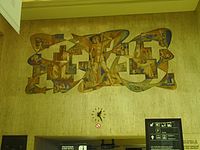
Interior mural
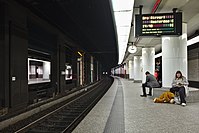
Platform 3

Interior entrance from the
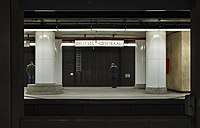
Sign seen from platform 3

Violinist in the hallway connecting the train and metro portions of Brussels Central Station
Metro station[]
 Gare Centrale/Centraal Station metro station | ||||||||||||||||
| Owned by | STIB/MIVB | |||||||||||||||
| History | ||||||||||||||||
| Opened | 17 December 1969 (premetro) 20 September 1976 (metro) | |||||||||||||||
| Services | ||||||||||||||||
| ||||||||||||||||
The metro station, also called Gare Centrale/Centraal Station, is located five minutes' walk from the railway station and can be accessed through a pedestrian tunnel. It is located under the Marché au bois/Houtmarkt. It first opened as a premetro (underground tram) station on 17 December 1969 on the tram line between De Brouckère and Schuman. This premetro line was upgraded to full metro status on 20 September 1976. Following the reorganisation of the Brussels metro on 4 April 2009, it now lies on the joint section of metro lines 1 and 5 which cross Brussels from east to west.
See also[]
![]() Media related to Brussels Central station at Wikimedia Commons
Media related to Brussels Central station at Wikimedia Commons
- List of railway stations in Belgium
- Art Deco in Brussels
- Joe Van Holsbeeck
References[]
- ^ "Gares : Bruxelles-Centrale en tête". La Libre. 10 June 2010. Retrieved 15 June 2011.
- ^ Aubry, Françoise; Vandenbreeden, Jos (1996). Horta — Art Nouveau to Modernism. Ghent: Ludion Press.
- ^ State, Paul (2004). Historical dictionary of Brussels. Scarecrow press. p. 122.
- ^ Aubry, Françoise; Vandenbreeden, Jos (1996). Horta — Art Nouveau to Modernism. Ghent: Ludion Press.
- ^ M. Nilsen; Railways and the Western European Capitals: Studies of Implantation in London, Paris, Berlin, and Brussels, Springer, 2008, p. 156.
- ^ "Bruxelles: la nouvelle gare centrale a été inaugurée". rtbf.be. 20 September 2010. Retrieved 18 July 2011.
- ^ Durant, Jerome (6 May 2010). "Le couloir de la gare centrale enfin rénové". rtbf.be. Retrieved 18 July 2011.
- ^ Ysebaert, Tom (26 September 2008). "Brussel-Centraal heeft extra spoortunnel nodig". Nieuwsblad.be. Retrieved 19 July 2011.
- ^ "Infrabel consults on Brussels bottleneck". Railway Gazette. 26 September 2008. Retrieved 19 July 2011.
- Brussels metro stations
- Railway stations in Brussels
- Railway stations opened in 1952
- Victor Horta buildings
- City of Brussels
- Railway stations located underground






